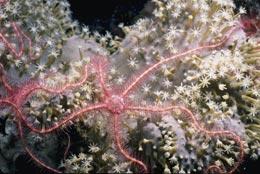But the biological cost of maintaining their skeletons may be too high.
 Brittlestars: some could grow faster in more acidic waters.Punchstock
Brittlestars: some could grow faster in more acidic waters.PunchstockAs carbon dioxide levels rise, most researchers have assumed that increasingly acidic oceans will compromise the calcification processes of ocean organisms.
But new results show that one delicate species, a brittlestar, actually bumps up the speed of shell production, or calcification, under such conditions1. This is the second species that has been recently reported to increase its rate of calcification in acidic waters.
The first report, released in Science, showed a widespread species of phytoplankton building its shells at faster rates, with seemingly no ill effects2 (see Phytoplankton responding to climate change). But the newest report, published today in Proceedings of the Royal Society B, shows that although brittlestars can do the same trick, they might not be so lucky.
The brittlestars — starfish-like creatures that burrow in coastal sediments — prevent more acidic ocean water from dissolving their spindly arms by creating more shell material from minerals in the surrounding water. To do so, they speed up their metabolism using up their own muscle to create the needed energy.
On balance, this response could ultimately leave the brittlestars paralyzed in their burrows. “The take-home message is that calcification is only one process that’s going to be affected,” says study author Hannah Wood, a marine biologist at the Plymouth Marine Laboratory, UK.
Armed conflict
Wood and her colleagues studied Amphiura filiformis, a species of brittlestar that lives off the coasts of Northern Europe.
To investigate the effects of ocean acidification on these creatures, the team studied brittlestars under four different levels of ocean acidity. The organisms were observed for 40 days, and the level of calcium in their arms was recorded, as was the amount of oxygen the brittlestars took in, which was used as a measure of metabolic rate.
Since predatory fish often bite off brittlestar arms, the team removed arms occasionally to study arm regrowth under acidic conditions. The brittlestars always succeeded in regrowing their arms, and surprisingly, the regrown arms were actually longer and contained more calcium under more acidic conditions than they did in ordinary-pH seawater.
But although the regenerated arms were apparently more robust in the more acidic water, the muscles inside all of their arms — the regenerated ones and the original ones — contained large empty spaces. Since brittlestars use their arms to collect food and burrow, the researchers speculate that the reduction in muscle will affect survival.
Trying too hard
"They are overcompensating,” says Wood. And in the long term, the muscular and metabolic strains will "create a deficit they can't maintain", she says.
"The point that they make is very important," says Christopher Sabine, a chemical oceanographer at the Pacific Marine Environmental Laboratory in Seattle, Washington. "It is something that we’ve been saying all along, that we need to look beyond calcification", to other effects of acidic waters on such organisms, he says. In the wild, Sabine adds, the consequences of ocean acidification may be more severe, as the brittlestars would have to compete for resources.
The fate of the brittlestars remains unclear. Survival rates of their larvae are so low that it can take decades to create a new generation. With ocean pH levels expected to plummet, "there's not enough generation time for evolutionary adaptation," says Wood.



No comments:
Post a Comment